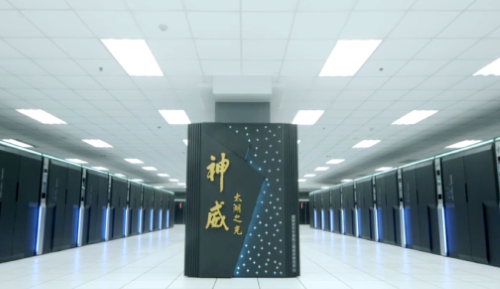Top ranked system uses China custom CPU

The Sunway system in Wuxi used a custom China processor to hit 93 petaflops/s. (Image: Top500)
SAN JOSE, Calif. — A new supercomputer in China—the first made with processors designed and made in the People’s Republic—has been ranked the world’s most powerful system by far. The news comes as China tops the U.S. for the first time in both the number and performance of systems on the latest Top500 list.
The Sunway TaihuLight at the National Supercomputing Center in Wuxi hit 93 petaflops/second on the Linpack benchmark and a theoretical peak performance of 125.4 Pflop/s. It uses 40,960 Sunway SW26010 processors designed by the Shanghai High Performance IC Design Center.
China’s Tianhe-2 already held the title of the world’s fastest supercomputer for the last three years, but it was built using Intel processors and an interconnect chip designed in China.
“The Sunway TaihuLight is almost three times as fast and three times as efficient as the [Tianhe-2] it displaces in the number one spot,” said Jack Dongarra, a computer science professor at University of Tennessee and co-author of the twice yearly Top500 list. The system is five times faster than the top ranked U.S. supercomputer, the Titan, a Cray XK7 system at Oak Ridge National Laboratory that hits 17.59 pflops/s, making it #3 in the world.
“For comparison, the next large acquisition of a supercomputer for the U.S. Department of Energy which is expected to be approximately 200 Pflops/s will not be until 2017 with production beginning in 2018,” wrote Dongarra in an 18-page report on the Sunway system.
Dongarra sounded a notes of both praise for China and alarm for U.S. technologists in his conclusion of the report:
The Sunway TaihuLight system demonstrates the significant progress that China has made in designing and manufacturing large-scale computation systems…The fact that there are sizeable applications and Gordon Bell [award] contender applications running on the system is impressive and shows that the system is capable of running real applications and not just a stunt machine.
In 2001 there were no supercomputers listed on the Top500 in China. Today China has 167 systems on the list compared to 165 systems in the US. This is the first time the US has lost the lead…It is clear that they are on a path which will take them to an exascale computer by 2020, well ahead of the US plans for reaching exascale by 2023.
The latest rankings are the result of China’s focused spending on supercomputing over the last three to five years while spending in the U.S. slumped, said Horst Simon, deputy director of the Lawrence Berkeley National Laboratory and another co-author of the Top500 list. The good news is the U.S. is getting back in the game with projects such as the National Strategic Computing Initiative, he said.
In particular, the competition to deliver the first exascale-class system has “never has been as close a race as it is now,” said Simon.

No comments:
Post a Comment